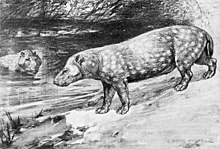Merycochoerus (Greek: "ruminant" (merux)-like "swine" (khoiros)[1]) is an extinct genus of oreodont of the family Merycoidodontidae, endemic to North America. They lived during the Early Oligocene 33.9—30.8 mya, existing for approximately 3 million years.[2] Fossils are widespread through the western United States.


Merycochoerus was a cud-chewing plant-eater with a long face, tusk-like canine teeth, heavy body, long tail, short feet, and four-toed hooves.[citation needed] The 1 metre (3.3 ft) long animals are thought to have been amphibious, as members of the genus possessed an elongated, barrel-shaped body and short limbs that are typical adaptations found in semi-aquatic mammals.[3]
Species
- M. carrikeri (syn. Promerycochoerus thomsoni)
- M. chelydra (syn. Promerycochoerus barbouri)
- M. magnus
- M. matthewi
- M. pinensis
- M. proprius
- M. superbus (syn. M. fricki, M. leidyi, M. macrostegus, M. montanus, M. temporalis, Promerycochoerus grandis, P. hatcheri, P. hollandi, P. inflatus, P. latidens, P. loomisi, P. lulli, P. marshi, P. microcephalus)
- M. vantasselensis
Resources
- ^ "Glossary. American Museum of Natural History". Archived from the original on 20 November 2021.
- ^ Merycochoerus at fossilworks
- ^ Palmer, D., ed. (1999). The Marshall Illustrated Encyclopedia of Dinosaurs and Prehistoric Animals. London: Marshall Editions. p. 271. ISBN 1-84028-152-9.









You must be logged in to post a comment.